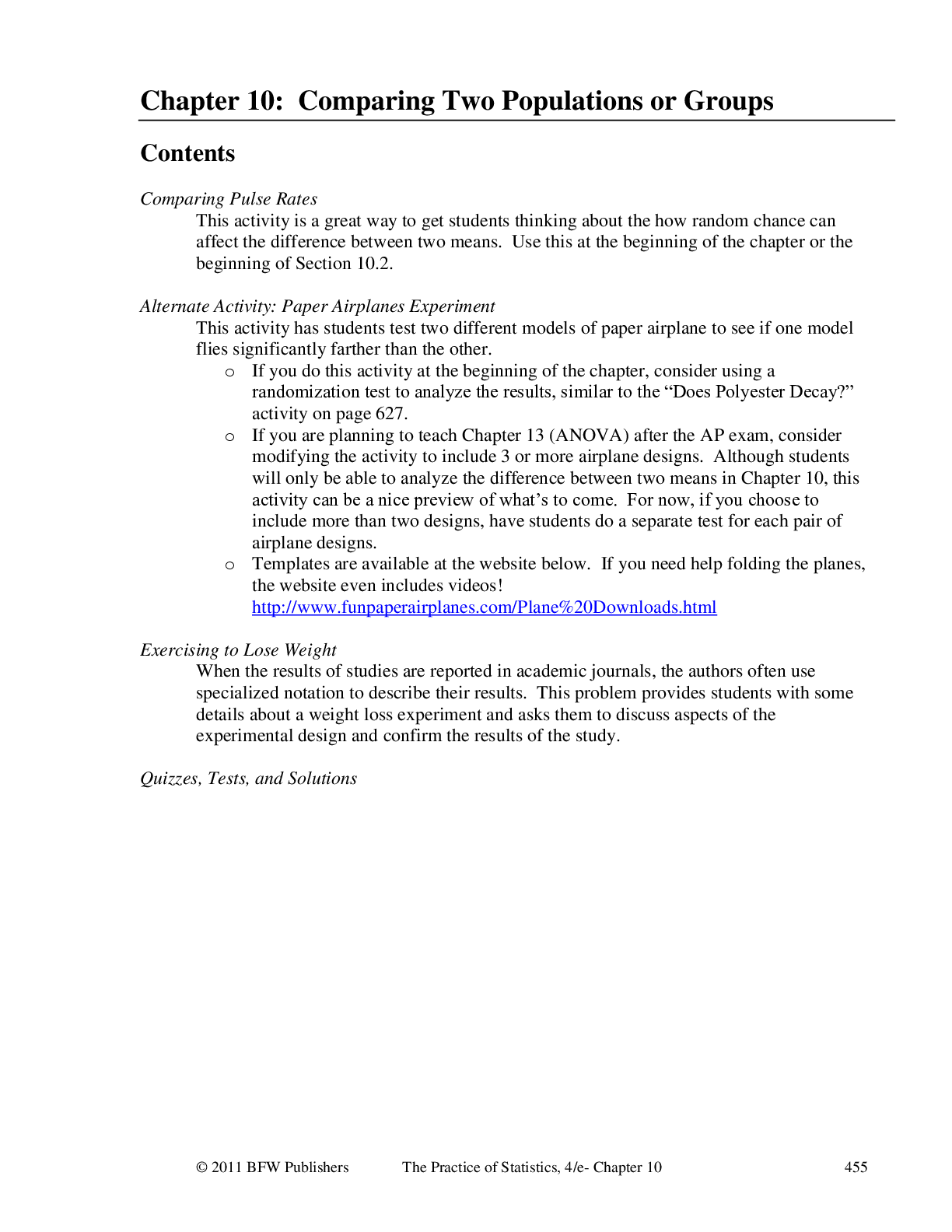Contents
Comparing Pulse Rates
This activity is a great way to get students thinking about the how random chance can
affect the difference between two means. Use this at the beginning of the chapter or the
beginning of Section 10.2.
Alternate Activity: Paper Airplanes Experiment
This activity has students test two different models of paper airplane to see if one model
flies significantly farther than the other.
o If you do this activity at the beginning of the chapter, consider using a
randomization test to analyze the results, similar to the ―Does Polyester Decay?‖
activity on page 627.
o If you are planning to teach Chapter 13 (ANOVA) after the AP exam, consider
modifying the activity to include 3 or more airplane designs. Although students
will only be able to analyze the difference between two means in Chapter 10, this
activity can be a nice preview of what’s to come. For now, if you choose to
include more than two designs, have students do a separate test for each pair of
airplane designs.
o Templates are available at the website below. If you need help folding the planes,
the website even includes videos!
http://www.funpaperairplanes.com/Plane%20Downloads.html
Exercising to Lose Weight
When the results of studies are reported in academic journals, the authors often use
specialized notation to describe their results. This problem provides students with some
details about a weight loss experiment and asks them to discuss aspects of the
experimental design and confirm the results of the study.
Quizzes, Tests, and Solutions
456 The Practice of Statistics, 4/e- Chapter 10 © 2011 BFW Publishers
Comparing Pulse Rates
Here is a nice Activity you can do at the beginning of Section 10.2 to let students experience the
idea of distinguishing between chance differences and ―real‖ differences in population means. It
was proposed by Professor James Lang (Valencia Community College, Orlando) and is used
with permission.
Place index cards, one for each student, in a box with half marked with the letter "A" and the
other half with "B." Then have each student randomly choose a card from the box. Next ask the
students to measure their pulse rate and write it on the back of the index card. Collect the cards
and write the data on the board for each group. Find the mean pulse rate for each group. Then
have a conversation like the following:
―I bet you didn’t know that the letter on the card influences your pulse rate.‖
There is silence followed by puzzled looks.
Then say, ―Yes. See, the mean for Group A is 83 and the mean for Group B is 79. [Your
numbers may vary.] So the letter affected your pulse.‖
More silence.
Then a student says, ―That difference is just due to variation in individual pulses . . . just
chance.‖
Then say, ―How much difference can we reasonably expect due to chance?‖
Since you already have each student’s pulse rate on an index card, shuffle the cards and divide
them at random into two stacks and find the difference in means. Do this over and over again,
each time recording the simulated difference of means on a dotplot. The resulting distribution
shows what types of differences we can reasonably expect due to chance.
© 2011 BFW Publishers The Practice of Statistics, 4/e- Chapter 10 457
Paper Airplanes
MATERIALS: Two paper airplane pattern sheets, scissors, masking tape, tape measures,
graphing calculator
Don’t forget that templates are available at the website below!
http://www.funpaperairplanes.com/Plane%20Downloads.html
The purpose of this Activity is to see which of two paper airplane models—A or B—flies
farthest. Specifically, the object is to determine whether there is a significant difference in the
average distance flown for the two plane models.
1. As a class, design an experiment to determine which of the two paper airplane models
flies the farthest. Be sure to follow the principles of experimental design you learned in
Chapter 4.
2. State the hypotheses you are interested in testing.
3. Carry out your plan and collect the necessary data.
4. Compare the flight distances for the two models graphically and numerically. Does it
appear that the means are about the same, or is one mean different from the other?
5. Perform a significance test to determine if the difference in means is significant.
Read More

